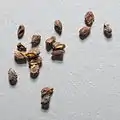| Neowerdermannia vorwerkii | |
|---|---|
 | |
| Scientific classification | |
| Kingdom: | Plantae |
| Clade: | Tracheophytes |
| Clade: | Angiosperms |
| Clade: | Eudicots |
| Order: | Caryophyllales |
| Family: | Cactaceae |
| Subfamily: | Cactoideae |
| Genus: | Neowerdermannia |
| Species: | N. vorwerkii |
| Binomial name | |
| Neowerdermannia vorwerkii Frič | |
Neowerdermannia vorwerkii, also known as achakana (Aymara and Quechua),[2][3][4] is a species of cactus from high altitudes in Bolivia and northern Argentina.[5]
Description
Neowerdermannia vorwerkii grows with depressed spherical, dark grey-green shoots 6 to 10 centimeters in diameter. The 16 or more ribs are divided into conspicuous, triangular protuberances between which the areoles are sunken. The 1 to 3 brownish to greyish central spines are often hooked and up to 2 centimeters long. The up to 10 curved and brownish radial spines have a length of up to 1.7 centimeters.
The white or light to bright purple-pink flowers are 1.8 to 2 centimeters long and have the same diameter. The spherical fruits are initially green, then reddish and are up to 5 millimeters in size.[6]
 Plant
Plant Seeds
Seeds
Distribution
Neowerdermannia vorwerkii is widespread in Bolivia and northern Argentina at altitudes of 3000 to 4000 meters. It grows buried in rocky soils in high mountain grasslands.
Taxonomy
The first description was made in 1930 by Alberto Vojtěch Frič. Nomenclature synonyms are Gymnocalycium vorwerkii (Frič) Hutchison (1959), Weingartia vorwerkii (Frič) Backeb. (1963), Sulcorebutia vorwerkii (Backeb.) F.H.Brandt (1976) and Coryphantha vorwerkii (Frič) Halda & Malina (2005).
Use
.jpg.webp)
In the cities of Oruro and Potosí in Bolivia, this cactus known as achakana is part of the population's diet, being consumed for its medicinal properties24 and also as part of the traditional dish Ají de achakana, characteristic of the All Saints Festival in Bolivia. Potosí. The cactus and its complete root are sold cooked and with the thorns removed for consumption in the city of Oruro.
In Jujuy, Argentina, this cactus is consumed as a potato substitute. In particular, it is used to prepare special dishes for the celebration of certain festivities.
References
- ↑ "The IUCN Red List of Threatened Species". IUCN Red List of Threatened Species. 2010-09-21. Retrieved 2023-10-23.
- ↑ "Diccionario Quechua - Aymara al español". katari.org. Retrieved March 4, 2016.
- ↑ "Achakana". Medicina Intercultural. Retrieved March 4, 2016.
- ↑ Teofilo Laime Ajacopa (2007). Diccionario Bilingüe: Iskay simipi yuyayk’anch: Quechua – Castellano / Castellano – Quechua (PDF). La Paz, Bolivia.
{{cite book}}: CS1 maint: location missing publisher (link) - ↑ Anderson, Edward F. (2001), The Cactus Family, Pentland, Oregon: Timber Press, ISBN 978-0-88192-498-5, p. 483
- ↑ Anderson, Edward F.; Eggli, Urs (2005). Das grosse Kakteen-Lexikon (in German). Stuttgart (Hohenheim): Ulmer. p. 444. ISBN 3-8001-4573-1.
External links
 Media related to Neowerdermannia vorwerkii at Wikimedia Commons
Media related to Neowerdermannia vorwerkii at Wikimedia Commons Data related to Neowerdermannia vorwerkii at Wikispecies
Data related to Neowerdermannia vorwerkii at Wikispecies
